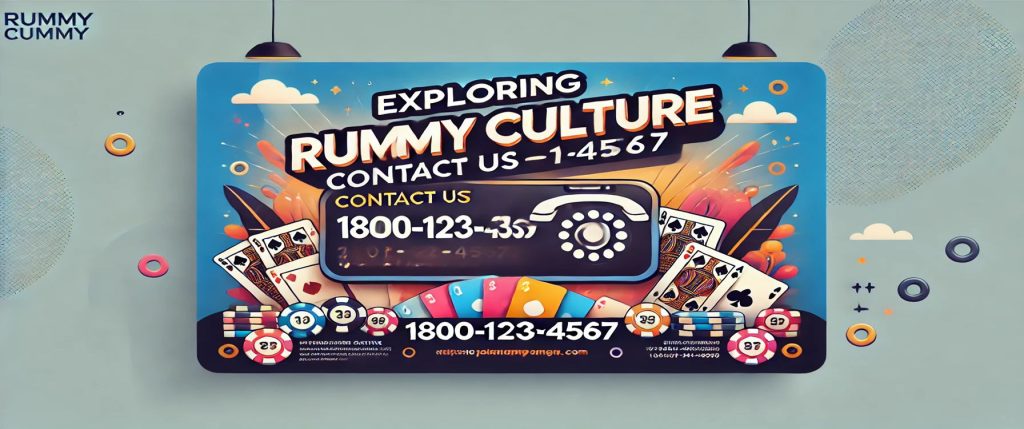
The Complete Guide to Rummy: Origins, Variations, & Cultural Influence Rummy, a popular card game played by millions of people worldwide, has a lengthy and intricate history that begins in the early 1800s. Its beginnings are a little unclear, but some theories contend that it might have developed from earlier games like “Conquian,” a Spanish game that is frequently cited as a forerunner of contemporary rummy. It is thought that Conquian originated in Mexico and was introduced to the US by immigrants from that country. It saw many changes as it traveled across borders, giving rise to the various variations of rummy that exist today. In the 1930s, when people were looking for inexpensive entertainment options during the Great Depression, the game became extremely popular in the US.
Rummy started to draw interest from both card players and game enthusiasts as its popularity grew. The invention of Gin Rummy by Elwood T. in 1909. The game’s development reached a turning point with Baker. Players soon came to love this version, which was also featured in popular culture, such as books and movies, because of its strategic depth and fast-paced gameplay.
Rummy has developed over the years, with numerous regional variations appearing all over the world. The cultural quirks of the communities that play them are reflected in the rules and strategies of each variation, from Indian Rummy to Kalooki. Rummy’s straightforward yet captivating gameplay serves as a testament to the timeless appeal of card games, spanning generations and cultures. vintage Gin Rummy. Gin Rummy is one of the most well-known variations; it is usually played in pairs and places an emphasis on strategic melding & deft card management.
Players’ goal in this version is to minimize the point value of their unmatched cards while forming runs or sets of cards. South Asians love Indian rummy. Indian Rummy is another noteworthy variation that has become extremely popular in South Asia. In Indian Rummy, which is played with two decks of cards & frequently involves more than two players, players must create legitimate sets and sequences while following certain guidelines for card draws and discards. Investigating Different Variations. Other variations include Kalooki, which is renowned for its distinct scoring system and gameplay mechanics, and Canasta, which combines aspects of strategy and teamwork.
Not only does each variation provide a unique experience, but it also captures the cultural influences that influence rummy play globally. With organized tournaments held all over the world, rummy has evolved from a recreational activity to a competitive sport. Players of all skill levels attend these tournaments, from novices looking to prove themselves to seasoned pros competing for coveted titles and cash payouts. Tournaments frequently have predetermined formats, like Swiss-style pairings or knockout rounds, which give competitors a controlled setting in which to demonstrate their abilities.
The excitement of competition gives the game a thrilling new dimension & promotes player camaraderie while showcasing individual skill. Rummy tournaments have become even more popular in recent years thanks to online platforms, which have opened up the game to a wider audience. From the comfort of their homes, players can now compete against opponents from around the globe in virtual tournaments.
The competitive nature of the game is increased by the frequent inclusion of leaderboards, rankings, and multiple prize pools in these online tournaments. It’s probable that even more creative formats and competitive opportunities will surface as rummy develops further in this digital age, securing its position in the competitive gaming industry. Although the main focus of rummy is skill and strategy, there are also unspoken rules that specify appropriate player behavior. In order to create a positive gaming environment and make sure that everyone has fun, it is imperative that everyone understands these etiquette rules. Keeping respect for other players is a basic component of rummy etiquette.
During gameplay, this involves avoiding distractions like excessive talking or using mobile devices, which can interfere with concentration and reduce the overall enjoyment of the game. Integrity and honesty in gameplay are crucial components of rummy etiquette. Gamers must strictly abide by the rules and refrain from any kind of manipulation or cheating.
Players’ trust is increased by this dedication to fair play, which also improves the game’s integrity. Also, it’s critical to be gracious in both wins & losses; praising opponents’ abilities and expressing gratitude for their efforts promotes a feeling of camaraderie within the game. Players can foster a fun environment that promotes friendship and respect for one another by abiding by these unwritten guidelines. The impact of rummy goes beyond card tables; over time, it has significantly impacted popular culture. The game, which frequently represents social interaction and leisure, has appeared in a number of movies, TV series, and books. Hollywood classics, for example, usually show characters playing rummy to strengthen their bonds or settle disputes.
In addition to highlighting rummy’s social function, this portrayal upholds the game’s standing as a generation-spanning cultural icon. Also, rummy has served as an inspiration for a variety of artistic mediums, such as music & visual arts. Songs that make reference to card games frequently evoke themes of human connection, strategy, and chance—elements that are fundamental to rummy itself. Also, rummy clubs & events have developed into social hubs where players from all walks of life congregate to share their passion for the game.
These group activities strengthen bonds & produce enduring memories, further integrating rummy into society. As a result, rummy promotes social interaction & cross-cultural exchange in addition to being a source of entertainment. Learning to play rummy involves more than just good fortune; it also calls for careful preparation and strategic thinking.
Paying close attention to the movements of opponents is a crucial tactic. Players can learn a great deal about their opponents’ hands and modify their tactics by being mindful of the cards they discard or pick up. Because it enables players to predict their opponents’ next moves & make well-informed decisions regarding their own cards, this level of awareness can give them a major advantage when playing. A key component of rummy strategy is efficient hand management. In order to minimize deadwood (unmatched cards) in their hands, players should try to form melds, such as sets or runs. Performance in the game can be greatly impacted by prioritizing which cards to keep or discard based on possible melds.
Players should also be adaptable in their strategy; success in the game depends on their ability to change course when conditions change. Players can improve their rummy skills and increase their winning chances by fusing quick observation with efficient hand management strategies. Technology’s introduction has completely changed how people play classic games like rummy. Because online platforms make it easy for players to access their favorite game at any time and from any location, they have become popular places to play rummy.
These online gaming platforms offer a number of features that improve gameplay, such as beginner tutorials, personalized tables for seasoned players, and choices for both recreational & competitive play. A worldwide community of players who can communicate across geographic boundaries has also been cultivated by online rummy platforms. Players can compete against opponents from other nations or areas, which broadens their knowledge of various tactics and playing styles. Those who are on the go can now play rummy on their smartphones or tablets thanks to the growth of mobile applications. With new features that increase user engagement and enjoyment, online rummy is probably going to continue to develop as technology advances. Rummy clubs & communities are crucial to fostering a common love of this classic card game.
Attending these events gives rummy fans the chance to meet people who share their passion for the game. Through neighborhood clubs or online discussion boards, players can discuss tactics, exchange pointers for getting better, or just watch friendly games with other fans. Engaging in rummy clubs also helps people feel like they belong to a wider community. Numerous clubs host frequent competitions or social gatherings where members can demonstrate their abilities and form bonds through common experiences. Individual gameplay is improved by these exchanges, which also support a thriving rummy culture that values both rivalry and friendship.
These communities will continue to flourish as more people come to appreciate the pleasures of playing rummy together, serving as essential gathering places for enthusiasts to interact and connect. To sum up, rummy is a cultural phenomenon that has changed over centuries in response to shifting social mores and technological breakthroughs, making it more than just a card game. Because of its lengthy history, wide range of variations, and competitive environment, rummy has captured the attention of players all over the world. Rummy continues to be a beloved game that promotes enjoyment & connection between generations, whether it is played competitively in tournaments or casually among friends.





